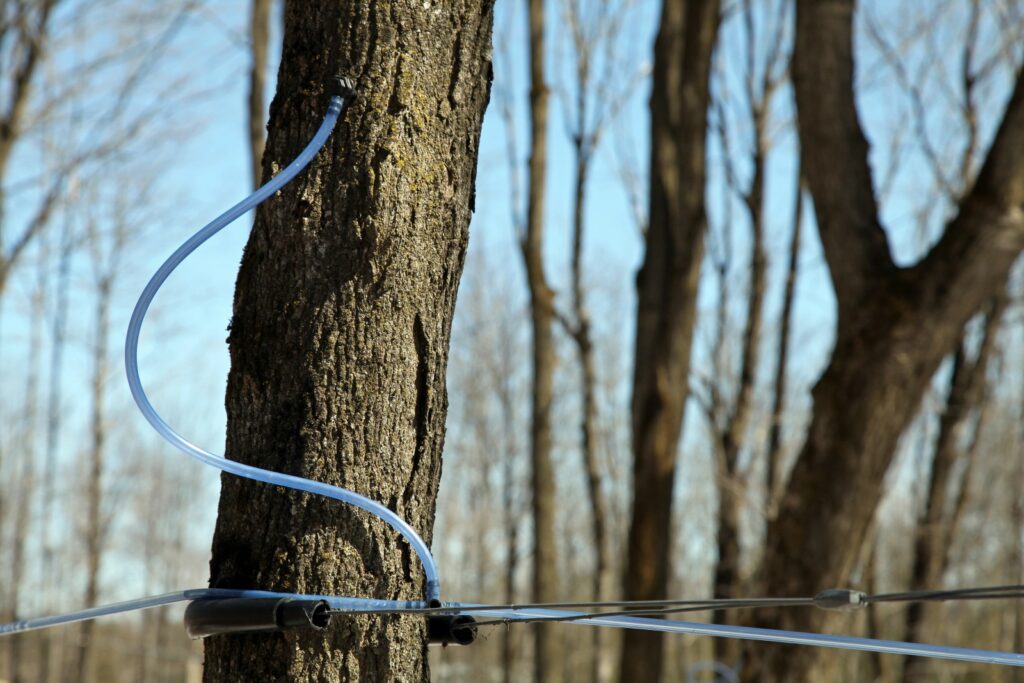
The use of vacuum pumps in maple syrup extraction has allowed even smaller producers to increase yields and expand operations but comes with its own unique set of challenges. We consider some of the problems typically associated with using a vacuum pump extraction and look at some promising solutions.
SWEET SPOT: VACUUM PUMPS TO OPTIMIZE SAP EXTRACTION

The introduction of affordable, efficient vacuum pumps into maple sap extraction has opened up new opportunities for many producers in what has always been a time-consuming, labor-intensive, and highly seasonal industry.
Vacuum-driven processing systems can increase yield across a tubing system by between 50% and 200% over a season, allowing more sap to be collected faster during critical short runs and extended thaws, and opening access to previously inaccessible sugarbush terrain.
Other advantages of vacuum-driven sap collection include:
- More tree taps per gathering system
- Longer seasons due to better collection in marginal conditions
- Reduced labor, especially in harsh weather conditions
- Improved tube hygiene due to higher sap flow rates
Taken together, these advantages have helped large operations to achieve true economies of scale while allowing many smaller producers to maintain and expand their operations.
VACUUM SAP PRODUCTION: FIVE PROBLEMS
At the same time, producers who have invested in vacuum pump systems can encounter problems related to the technology. These include:
1. LOSS OF VACUUM
While vacuum systems drive more sap during runs, maintaining effective vacuum differentials, both within sapwood and across larger tap systems, is a serious challenge. Vacuum systems must be strong enough to maintain the negative pressure required for extraction through the taphole while compensating for leakage throughout the tubing system.
2. WATER VAPOR
The high levels of water vapor associated with tree sap make condensation inside piping and the pump itself a particular problem in sap extraction systems, leading to increased maintenance costs, equipment downtime, and the shortening of the pump’s life.
3. MAPLE SAP CONTACT
Similarly, contact with tree sap itself and associated water can lead to blockages in pump systems. This can also wear on mechanisms, thereby decreasing efficiency and increasing equipment costs.
4. POWER CONSUMPTION
Vacuum equipment increases power consumption during peak spring demand periods, and is a key cost determinant for both large and small producers.
5. SUNK EQUIPMENT COSTS
Investing in vacuum collection means becoming dependent on your equipment, including your pump technology as well as managing and maintaining the larger tap system it supports.
DEEP VACUUM EXTRACTIONS: CHALLENGES AND OPPORTUNITIES
Despite these challenges, the use of increasingly powerful vacuum extraction systems is continuing and is supported by research: agricultural scientists at the University of Vermont have found every additional inch of mercury pressure (Hg) applied to a tapping system increases sap yield by 5-7%.
Within the last 30 years, farmers have steadily raised what was considered the highest practical vacuum pressure for tapping systems from below 15” Hg to well above 20” today, with many producers now working with high or “deep” vacuum extraction above 25” Hg.
While the gains from deep vacuum extraction are clear, the process increases many of the challenges already inherent in using pumps in maple extraction, including:
- Increased taphole staining and blocking and reduced tap life
- More tubing leaks and air blocks
- Increased pump exposure to water vapor and sap
- More power consumption
TAPPING EFFICIENCY
In response, University of Vermont researchers are working on redesigning spouts to maintain higher pressure in sapwood surrounding the taphole. The scientists say the redesigned spouts increase sap flow by up to 20% with a significant improvement in sugar content and are particularly effective during short sap runs.
PULLING POWER

The move is supported by the development of more powerful, efficient, and easy-to-maintain pumps suitable for the harsh conditions of the sugaring industry, such as Becker Pumps’ U Series “oil-flooded” vacuum units.
Becker’s U Series pumps are designed to deliver more power from highly efficient IE3 motors, providing deep vacuum pressures of up to 29” Hg for the largest sap-gathering systems and most challenging terrains.
Our lubricated rotary vane mechanisms are ideal for pumping saps with high water vapor content. Units are also equipped with fully adjustable gas ballast filters that allow excess vapor to be vented directly from the unit during operation.
High-efficiency two and three-stage oil separation proves an additional level of protection.
SAPSUCKER UNITS
Built for years of efficient operation and once-in-a-season maintenance, U Series pumps are supplied as part of Becker’s Sapsucker sap vacuum units, which also include:
- High-efficiency air/liquid separators
- External filters to keep water and sap “slugs” out of the pump
- Moisture release/flow control valves
Fully-lubricated pumps are suitable for season-long outdoor operation and offer unparalleled cold start performance. They are also capable of running on either single-phase or three-phase power to maximize sap yield while minimizing cost.
MAKE IT RIGHT, MAKE IT BECKER
Investing in deep-vacuum equipment is a big step for any maple sugar farmer. If you’re ready to make the commitment, we’re ready to support you with a range of powerful, efficient pumps that provide unparalleled performance, reliability, and return on investment.
Whether you’re running 400 taps or 40,000—Becker has a deep vacuum pump to help you keep sap flowing faster and longer when it counts. Click below to learn more.

